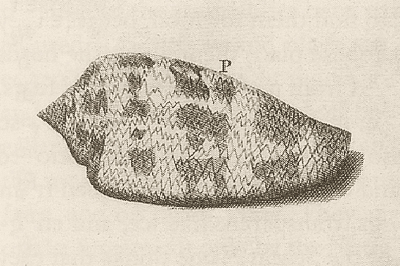
The earliest death from a cone shell was reported by the German naturalist George Everhard Rumphius, who spent much of his life in the employ of the Dutch East India Company on the island of Ambon in the Moluccas. In the D'amboinsche Rariteitkamer ("The Ambonese Curiosity Cabinet"), published posthumously in 1705 (but begun decades earlier), he records both the envenomation, as well as observing that the venom was injected by means of a harpoon-like radular tooth. Rumphius understood the deadly shell to have been a type of Voluta pennata, which had several forms.
"The yellow kind [C. textile] are called Partridges (attagenes) or Gold Cloth, because their entire body is painted with yellow feathers, that have black edges, almost like the feathers of that Bird: The second kind is somewhat smaller, and narrower...painted brown and white like feathers, and is called Silver Cloth [C. omaria]; both have a narrow mouth, and can stick out a little tongue, that is white, edged with red, and in it is a small bone, or thorn, which will hurt you, if stung by it. The third or brown kind [possibly C. geographus], is different, larger, also painted brown and white, but the feathers are not arranged as orderly; they have a deathly color, and are finely ribbed along the whorls. Although the Attagenata are caught and eaten daily, they are not innocent of poison, which was experienced by a slave woman on Banda, who knew that she had only held this little Whelk in her hand, which she had picked up out of the Sea, while they were pulling in a Seine net; and while she was walking to the beach, she felt a slight itching in her hand, which gradually crept up her arm and through her entire body; and so she died from it instantaneously" (II.21.10, p. 105).
Certainly, the feathered pattern and white, red-tipped siphon are descriptive of both C. textile and C. omaria. And the "third or brown kind" is similar to C. geographus. But Rumphius identifies that shell as one of the Nubeculae (II.21.6), "somewhat knobby at the head...with a wide mouth, and a thin shell; the biggest kind is brown, with dirty white specks." These indistinct white clouds give the shell its name, "little clouds." C. geographus is illustrated in Plate XXXI as Figure G, where it is labeled as Agate Kroonbak or "Agate Crownscoop." Bak here is translated by Beekman as "scoop," suggesting that these shells, which "are very large and have wide mouths," were sometimes used to bail water. Whether Rumphius' third kind actually was C. geographus cannot be known, although Kohn suspects that it was, given how very quickly the native woman died. To be sure, the venom of C. textile, which hunts other mollusks, is not as toxic as a fish eater such as C. geographus, which also is more aggressive. But the victim could have been young and so more vulnerable to the sting of C. textile, or the "little Whelk" may have been an immature C. geographus.
Situated in the open sea about 125 miles southeast of Ambon, the Banda Islands were famous for their nutmeg. Rumphius had visited several times, first to inspect the location for a fort (1657) and then on an inspection tour of the islands' fortifications (1663). The previous year, he recounts sailing for an entire day through a sea of Portuguese Man of War on the way back to Ambon. Perhaps he heard about the incident while on one of these voyages. Even at the time, the death must have been regarded as exceptional for him to have recorded it.
Kohn suggests that the envenomation "occurred around 1670." Rumphius was blinded by glaucoma that year, but all his works were written or completed afterwards. The manuscript for The Ambonese Curiosity Cabinet, for example, was not finished until September, 1699 (as the Dedication attests)thirty years later. It is possible, therefore, that the death could have been later or even some time earlier, although circa 1670 seems as convenient a date as any.
The illustration of C. textile (above) is from Plate XXXII, Figure P in the The Ambonese Curiosity Cabinet (C. omaria is Figure O). Rumphius inadvertently reversed the labels, however, mistakenly identifying the "Gold Cloth" (the shell still is known as the "Cloth of Gold") by the Letter O and the "Silver Cloth" by P. A half century later, Lennaeus classified Rumphius' Voluta pennata as C. textile (Systema Naturae, No. 278, p. 717), citing both figures as illustrative. C. omaria, in fact, is a distinct species, as Hwass recognized in 1792.
References: Amboinsche Rariteitkamer (Bk. II) (1705) by Georgius Everhardus Rumphius; The Ambonese Curiosity Cabinet: Georgius Everhardus Rumphius (1999) translated by E. M. Beekman; "Conus Venom Peptides: Reflections from the Biology of Clades and Species" (2002) by Baldomero M. Olivera, Annual Review of Ecology and Systematics, 33, 25-47; "Human Injuries and Fatalities due to Venomous Marine Snails of the Family Conidae" (2016) by Alan J. Kohn, International Journal of Clinical Pharmacology and Therapeutics, 54(7), 524-538; Systema Naturae per Regna Tria Naturĉ (10th ed., Vol. I) (1758) by Carolus Linnĉus.
